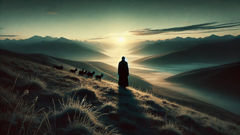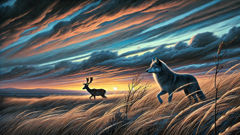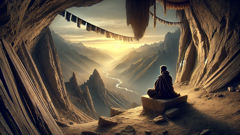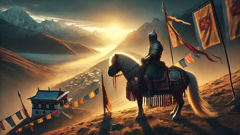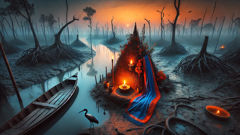Introduction
They say the Altai begins and ends where the horizon forgets to stop. For caravans of cloud and for the grazing herds of argali sheep, the range is a spine of weather and silence; for the people who live where wind scrapes like a dull blade, it is also a ledger of stories. The Almas—wild, shaggy, sometimes frightening, sometimes sorrowful—has been written into that ledger across generations. In the low smoke of gers, elders will draw the shape of a large footprint in the earth and name it with a slow, grave voice, as if announcing a presence that taught the mountains manners. To speak of the Almas is to meet a border: between human and animal, memory and invention, respect and fear. This is not a textbook entry, nor a dismissive newspaper column. It is an attempt to hold the smell of pine resin, the rasp of wind through larch needles, the cadence of a herder’s confession, and the sober curiosity of a visiting researcher all in the same breath, to let the legend breathe as it has in the mouths of shepherds on ridgelines and in the quick footnotes of Soviet-era naturalists. On a clear dawn, light will stripe the slopes in pale gold and a silhouette will sometimes be seen—lean-backed against rock, or crossing a valley like a question. Those who have glimpsed the Almas speak differently: some curse, some bless, some turn their faces away. The mountain does not count their choices. It keeps its own counsel. This story winds those counsels into a single thread, tracing how a distant creature became a living part of a landscape’s identity, how science and superstition have shared the same campfire, and how the Almas persists because people on this land still listen to mountains rather than simply pass through them.
Roots: Naming the Wild
The first time I heard the name I was not a scholar but a guest. A young herder, cheeks raw from wind, led a horse with a spindly foal at heel and spoke the word slowly as if testing its syllables against stone. 'Almas,' he said. It rolled in his mouth like river pebbles. Around the fire that evening his grandmother—she had skin like well-weathered leather and eyes quick as a lynx—told a story that laced history, terror, compassion, and a calendar of seasons together in the way only oral narrators can. She spoke of an ancient child of the steppe, one born before permanent fences and before guns, who learned to walk in shadow and to make a dwelling in the lee of cliffs. People named him Almas—the mountain man—when they needed to explain footprints that were too broad for wolves and too sure for a wandering hunter. The name is not a single thing. Across Mongolian dialects and neighboring Turkic tongues, words converge and diverge; sometimes the creature has attributes of a human whose bones were never buried properly, sometimes of a towering, hairy animal that could stand upright. In valley markets and ger circles the Almas is described in forms that slide between categories: a hominid with long hair, dark eyes, a smell of musk and sap; a spectral figure that appears to those who disrespect the land; a guardian, perhaps, of places people no longer visit. The more I listened, the clearer it became that the Almas functions less like a zoological claim and more like a cultural seamstress, stitching together memories of missing kin, of children lost in blizzards, of men who never came home. Stories of the Almas also mapped human relationships with the mountains. Elders told of hunters who took too much and were warned by low, guttural calls in the night; of shepherds who, upon finding lichen-cut stubble along a narrow ledge, learned humility and left the grazing alone; of lovers who wandered too far into the rocks and returned with hair frosted like hoarfrost and eyes glittering with a truth they couldn't explain. The creature's footprint—broad, bellied, sometimes splayed—is a recurrent motif. When pressed for more tangible accounts, many villagers would point to an object's history rather than detail an encounter: the old sash of felt left at the foot of a rock, the stretched sinew on a shepherd's bow that did not fray despite years, a set of childlike handprints near a hot spring. In this way, objects carry witness. They anchor belief in the world because people here have learned to read the land like a ledger of deeds. I learned another thing: the Almas lives in the verbs of the people. They do not merely 'see' it. They 'leave it be,' 'speak to it,' 'avoid its valley in winter.' Those verbs suggest reciprocity—a practice of coexistence that predates formal property and conservation laws. In recent decades, external observers tried to tidy the story with categories. Soviet naturalists sent notes and recorded sightings, sometimes classifying the accounts under misidentified large mammals, at other times attributing them to groups of displaced hominids. Western cryptozoologists later came with cameras and heavy theories, hungry for proof that would transmute story into specimen. Neither approach satisfied the nomads, who remained patient stewards of their oral maps. They saw the intrusion of instruments as a kind of arrogance; proof, to them, would be the same as turning a living relationship with the land into an exhibit. Instead they offered up a different kind of knowledge: where the animal preferred to drink, which ridgelines were sacred, the taste of an Almas' favored berries, the songs that might be sung to soothe an unseen child. This kind of information was not useful to those wanting specimens, but it was everything to the communities who valued rhythm over record. Linguistically, the Almas sits at a crossroads. The word's etymology, debated by philologists and elders alike, may be a mosaic of Turkic and Mongolic roots tied to wildness, solitude, and the idea of being 'outside' human naming conventions. This lexical slipperiness mirrors the creature’s place in culture: a placeholder for wonder and the reminders of limits. For people of the Altai, these limits are practical. They measure their lives by weather, by the migration of flocks and by where not to walk in winter. The Almas is another item on that list—not an enemy marked for eradication, but a boundary signed by footprints and warnings and ritual. When a traveling ethnographer asked whether the Almas should be protected, a herder shrugged and replied in a tone that carried both care and indifference: 'It has always been protected by its being feared and respected. We do not need a paper to protect what we already keep in our stories.'
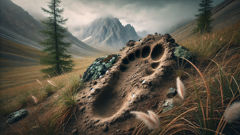
Sightings, Science, and the Shape of Belief
Not all sightings are equal. Some are the soft edges of memory: a form seen at dusk, the impression of a broad shoulder moving through wind-lashed grass. Others are acute, visceral, the kind of encounter that rearranges a person's life. I met a woman named Sagaan whose voice still quavered when she described the night she nearly tripped over something asleep in a hollow near a mineral spring. 'It was like waking a stove,' she said. 'Warm breath, and it smelled of sweet herbs. It lifted its head slowly and looked at me. The eyes—dark, round—held me and I felt the world tilt.' She fled then, barefoot across cold stone, her feet leaving thin tracks that a neighbor later found and followed to a shallow den lined with moss and a single braided lock of hair. Stories like Sagaan's are embroidered into the fabric of local memory, and each addition strengthened the communal conviction that the Almas was not merely metaphor. Over the last century, the Almas drew different kinds of attention. During Soviet times local field stations logged sightings with meticulous, bureaucratic neutrality. Photographs were taken, sketches made, and notebooks kept in stacks. Yet many reports were filed under more prosaic labels—large ursine activity, misidentified moose behavior, or human trespassers—because strict taxonomy did not allow for a 'wild man' without fossil evidence. Later, amateur cryptozoologists arrived from Europe and North America with infrared traps, plaster for footprints, and a hunger for sensational evidence. Some left with collections of photographs showing blurred shapes on ridgelines; others left with long lists of witness statements. Scientific interest waxed and waned depending on funding and novelty, but the mountain remained indifferent to expedition schedules. Modern naturalists who study the Altai bring more nuanced approaches. They trace animal corridors, collect DNA from hair and scat, and use acoustic monitors tuned to record low-frequency calls. Such methods have produced fascinating, if inconclusive, data: hair samples that do not match known local species exactly but also exhibit contamination; audio recordings of guttural, unclassified calls that could belong to large canids, moose, or an as-yet-undescribed noise. When sample results are inconclusive, the temptation for both skeptics and believers is to fill the gaps with certainty—either to declare fraud or to proclaim discovery. Yet the most interesting findings often lie not in a single piece of evidence but in the network of consistent patterning across accounts. Multiple shepherds on different ridgelines, for instance, will note similar behaviors: the Almas stands apart at a distance of roughly a hundred meters, it avoids human structures, it knits or arranges found objects in a simple order, and it shows curiosity rather than outright hostility. There is a rhythm to these observations that suggests a real agent navigating the landscape in a repeatable way. Far from proving species classification, the pattern argues for an intelligent, adaptable presence that has learned to observe human behavior and to modulate contact. Cultural context offers crucial interpretation. For generations, people in the Altai have been practiced observers of nonhuman intelligence: wolves that travel with goat herds, ravens that lead hunters to the dead, marmots that forecast climate. To interpret an Almas sighting as merely a misidentified known animal is to ignore how communities parse subtle cues in animal behavior. Conversely, to declare a cryptid species without rigorous corroboration risks collapsing a rich social phenomenon into a display specimen. I watched a researcher named Dr. Petrovich take apart both tendencies with an old lesson: 'Science is good at asking how, not why you care,' he said. 'But when the why is important to a human population, we must let their reasons inform our science.' Rituals around the Almas underscore this point. In some hamlets a family that finds an unusual tuft of hair or a set of prints will leave it be, marking the site with a simple pole topped with prayer cloths. In other places, elders lead small ceremonies calling benevolence from the unseen, offering dried tea, smoked milk, or a scrap of woven cloth. These are neither superstition for the sake of it nor mere theatrics; they are codes of conduct that regulate interactions between humans and an unpredictable presence. Observers who record rituals without acknowledging their practical function miss how they shape behavior—how they reduce conflict and, perhaps, how they conserve uncertain populations by discouraging hunting or close approaches. The Almas also reveals itself at the margins of modernity. Where roads end and telephone signals die, people still report glimpses: a heavy figure crossing near a power line cut; a brief congregation of wild dogs that disperses upon the creature's arrival; sheep found strangely intact in precarious places. In a world where satellite images parse every slope, such stories are stubborn. They complicate a global discourse that often wants to render the unknown into datasets and press releases. Instead the Almas, as told by those who live with it, remains a hybrid of living history and ecological intelligence. That hybridity is part of its appeal. In the city, the Almas becomes a headline. In local memory, it is a neighbor to winter storms, a participant in the seasonal calendar, a bearer of moral lessons. Children are taught not to laugh at signs or to take what is not offered, not because the Almas is a monster but because boundaries are necessary in a world of scarce resources. The creature's moral presence is sometimes subtle: a man who tried to trap what he thought was an Almas returned a year later to tell a story of shame—how his nets had pulled at a limp, heavy bundle and he had found not a malevolent beast, but the body of a young man who must have wandered and died alone. The community's response then was less triumphal and more mournful, and the Almas, for a moment, functioned as a reminder of vulnerability. This interplay between compassion and fear is essential to understanding why the legend persists. Anthropologists talk about 'ontologies'—different ways of being that societies use to describe reality. The Almas invites an ontological pluralism: it is possible simultaneously to approach the phenomenon as ecological puzzle, as living cultural practice, and as moral symbol. That triad sustains the story. It also frustrates those who want tidy answers. But perhaps the most persuasive thing the Almas teaches us is patience. The mountains move slowly; people who know them learn to slow their questions. In that waiting, the Almas remains ambiguous, and in ambiguity lies the space where respect and curiosity can coexist.

Conclusion
The legend of the Almas endures because it lives in the intersections: at the edge of human settlements and the wilds beyond, in the careful gestures of ritual and in the unsteady frames of modern cameras, within the pages of scientific notebooks and in the quiet offering of tea to an unseen guest. The Almas resists easy categorization because it sits where categories fray. For Mongolian herders, it is a living law of respect; for folklorists, a repository of cultural meaning; for curious outsiders, an invitation to wonder. In the end, the mountain keeps its own council. Those who come looking solely for proof often leave empty-handed, not because the creature never existed but because they did not learn the language of the slope. Those who slow down, who ask what the mountains have always required—listening, restraint, humility—are more likely to find something worth carrying: a story, a footprint, perhaps the soft impression of a life lived in parallel to human ambition. If the Almas is real in the biological sense, it has learned the art of vanishing into a world that does not honor it by naming alone. If it is primarily a story, it teaches practical lessons about coexistence in a landscape that gives and takes with little ceremony. Either way, the Almas occupies the same essential role it always has: a reminder that certain places are not solely ours, and that sometimes the most important boundaries are not the walls we build but the respect we practise.

